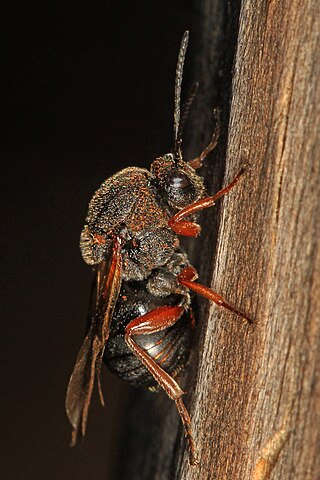
Gall wasps, also traditionally calledgallflies, are hymenopterans of the family Cynipidae in the wasp superfamily Cynipoidea. Their common name comes from the galls they induce on plants for larval development. About 1,300 species of this generally very small creature are known worldwide, with about 360 species of 36 different genera in Europe and some 800 species in North America.

Andricus kollari, also known as the marble gall wasp, is a parthenogenetic species of wasp which causes the formation of marble galls on oak trees. Synonyms for the species include Cynips kollari, Andricus quercusgemmae, A. minor, A. indigenus and A. circulans.

Andricus foecundatrix is a parthenogenetic gall wasp which lays a single egg within a leaf bud, using its ovipositor, to produce a gall known as an oak artichoke gall, oak hop gall, larch-cone gall or hop strobile The gall develops as a chemically induced distortion of leaf axillary or terminal buds on pedunculate oak or sessile oak trees. The larva lives inside a smaller hard casing inside the artichoke and this is released in autumn. The asexual wasp emerges in spring and lays her eggs in the oak catkins. These develop into small oval galls which produce the sexual generation of wasps. A yew artichoke gall caused by the fly Taxomyia taxi also exists, but is unrelated to the oak-borne species. Previous names or synonyms for the species A. fecundator are A. fecundatrix, A. pilosus, A. foecundatrix, A. gemmarum, A. gemmae, A. gemmaequercus, A. gemmaecinaraeformis and A. quercusgemmae.

Neuroterus is a genus of gall wasps that induce galls on oaks in which the wasp larvae live and feed. Some species produce galls that fall off the host plant and 'jump' along the ground due to the movement of the larvae within.

The common spangle gall on the underside of leaves and the currant gall on the male catkins or occasionally the leaves, develop as chemically induced distortions on pedunculate oak, or sessile oak trees, caused by the cynipid wasp Neuroterus quercusbaccarum which has both agamic and bisexual generations.

Cynips is a genus of gall wasps in the tribe Cynipini, the oak gall wasps. One of the best known is the common oak gall wasp, which induces characteristic spherical galls about two centimeters wide on the undersides of oak leaves.

Cynips quercusfolii is a gall wasp species in the genus Cynips. The species is important for the production of commercial nutgall formed on Quercus lusitanica . Galls are located on the underside of leaves, with the majority of galls being on the second and third veins from the petiole of the leaf.

Cynipini is a tribe of gall wasps. These insects induce galls in plants of the beech and oak family, Fagaceae. They are known commonly as the oak gall wasps. It is the largest cynipid tribe, with about 936 to 1000 recognized species, most of which are associated with oaks. The tribe is mainly native to the Holarctic. Cynipini wasps can act as ecosystem engineers. Their galls can become hosts of inquilines, and the wasps themselves are hosts to parasitoids.

Andricus dimorphus, also called the clustered midrib gall wasp, is a species of oak gall wasp in the family Cynipidae. Galls in which the larvae live and feed are formed in clusters along the midrib on the underside of oak leaves.

Cynips douglasii, the spined turbaned gall wasp, is a species of gall wasp in the family Cynipidae. It induces galls in valley oaks, blue oak, and scrub oaks. These galls are noted for their spines and can be white, purple, or pink. They can be up to 15 mm high and 10 mm wide. For the unisexual generation, female adult wasps emerge from the galls in January and February. The smaller bisexual generation emerges in spring and produces rounder galls.
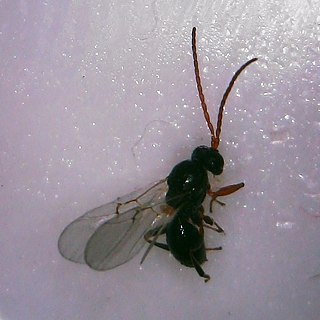
Andricus quercuspetiolicola, also called the oak petiole gall wasp, is a species of oak gall wasp in the family Cynipidae. Galls in which the larvae live and feed are formed along the midrib or petiole of white oak leaves.

Cynips quercusechinus, the urchin gall wasp, is a species of gall wasp in the family Cynipidae. It induces galls in the leaves and leaf buds of blue oak and scrub oak. Like other oak gall wasps, it has two generations: a bisexual generation, and a parthenogenic female generation. In spring, the hatching bisexual generation produces hollow green galls in leaf buds. In summer, the unisexual generation induces its galls, which are red or pink and resemble sea urchins, on the undersides of leaves. These galls are about 10 millimetres (0.39 in) in diameter. The galls fall with the leaves in autumn, and the larvae inside of them emerge as adults in the spring and lay their eggs.
Antron is a genus of gall wasps in the tribe Cynipini, the oak gall wasps. Some authors have included it within the genus Cynips but it was recently resurrected. The genus was established by Alfred Kinsey in 1930.
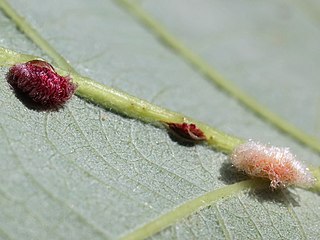
Druon ignotum is a species of gall wasp in the family Cynipidae.
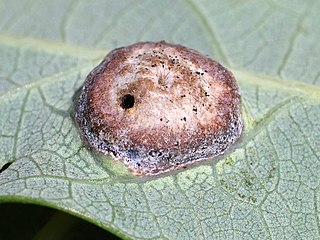
Callirhytis quercusfutilis, the oak wart gall wasp, is a species of gall wasp in the family Cynipidae.

Acraspis guadaloupensis is a relatively uncommon species of cynipid wasp that produces galls on intermediate oaks. The intermediate oak disc wasp was first described in 1911 and has been moved between genera more than once. Distribution is limited to California in North America. The flattened galls appear on leaves of Quercus chrysolepis, the canyon live oak.
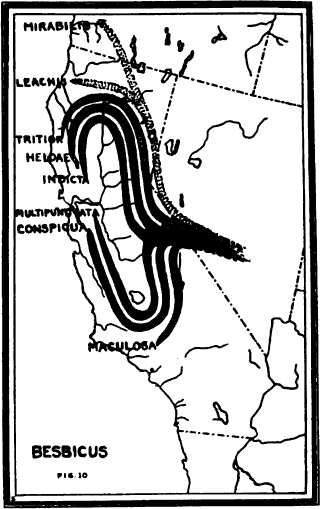
Besbicus is a genus of gall-inducing cynipid wasp found in North America. Several species now classed as Besbicus were formerly considered to be a part of the genus Cynips. Besbicus was originally described as a subgenus by Alfred Kinsey in 1929. Circa 2010, one group of entomologists noted that it was "possible that the nearctic genera Antron and Besbicus were erroneously synonymized to Cynips".

Besbicus conspicuus, formerly Cynips conspicuus, also known as the fuzzy gall wasp, is a common species of cynipid wasp that induces globular stem galls on white oak trees on the west coast of North America. This gall is solid but for the central larval chamber. After the wasp emerges, beetles sometimes chew through the husk to consume the tissue inside. Besbicus conspicuus galls are sometimes mistaken for Disholcaspis washingtonensis galls. This wasp is found west of the Sierra Nevada range in California in North America.

Besbicus multipunctatus, formerly Cynips multipunctatus, also known as the gray midrib gall wasp, is a common species of cynipid wasp that induces galls on oak trees on the west coast of North America. The wasp oviposits on the midrib of the underside of blue oak leaves. The galls induced by this wasp are solid, except for the large central larval chamber, and are detachable. This wasp is found primarily, but not exclusively, in California.
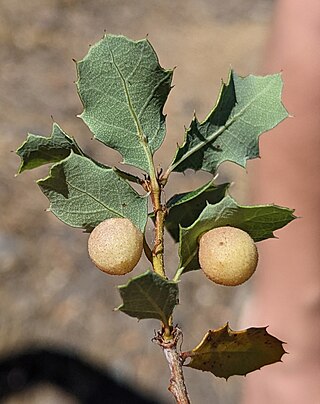
Besbicus maculosus, formerly Andricus maculosus and Cynips maculosa, also known as the pear gall wasp, is a uncommon species of cynipid wasp that induces galls on oak trees on the west coast of North America. The wasp oviposits on leather oak and scrub oak leaves. Fresh galls are green. This wasp has been observed in California.



















